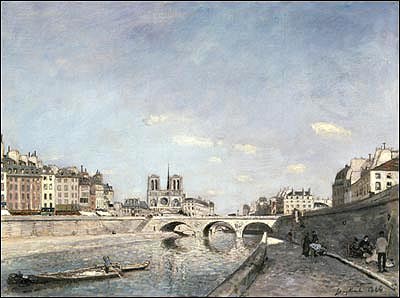When the Dutchman Jongkind discovered Paris at the end of the reign of Louis-Philippe, it was a revelation to him. The young landscape painter had been attracted to the capital by the painter Eugène Isabey, whom he had met in The Hague, and he was to paint some of his major works in this city. After ten relatively successful years spent there, he was finally accepted at the Salons, where he won a Third Class medal in 1853, and two of his paintings were bought by the State in 1851 and 1853. However, the fact that he did not recieve a prize at the Universal Exhibition of 1855 – in which he competed in the French section – was a harsh blow to the already fragile artist; “it's unbelieveable how I was treated…they didn't even give me a 'mention honorable', nothing”. A difficult return to his native land was followed by several short visits to Paris. Finally, in 1860, as a result of the support of the French artists Corot, Daubigny and Diaz, he was to return to live in France. Deeply moved by the Normandy coast (like his friend Baudin), he became a significant influence on Monet in latter's formative years. In 1863, he exhibited three works with the Refusés, and the art critic Castagnary commented (in a remarkable premonition): “With Jongkind, everything is in the impression”.
Steeped as he was in the Dutch landscape tradition of canal painting, Jongkind was to produce many paintings of Paris and the river Seine with its remarkable vistas, banks, and bridges. His however was a poetic vision of the city, a Paris of the people – he always painted a few figures, modest workers, and avoided the 'grande ville', the crowds and the construction work begun by the imperial regime. He was particularly fond of the cathedral of Notre-Dame and beautiful perspective view of it along the banks of the river, since it gave him the chance to play off the different qualities of the light reflected off the stone and the water and coming from the sky. However, he never painted the cathedral as a monument in its own right; he used it simply as a backdrop or, like here, as a silhouette in this view from the Quai Saint-Michel. The classical composition is that of the Dutch landscape tradition: low horizon, long diagonals, the primacy of the sky (it encompasses more than two-thirds of the canvas). However it is the restless, energetic and fragmented brushwork and the close observation of nature that lends freshness to Jongkind's palette and which reveals him above all as a precursor of the Impressionists; “As to the definitive education of my eye, I owe it all to him,” declared Monet.
Karine Huguenaud (tr. P.H.)
June 2004
The Seine and Notre-Dame de Paris
Artist(s) : JONGKIND Johan Barthold

- Date :
- 1864
- Technique :
- oil on canvas
- Dimensions :
- H = 42 m, L = 56.4 m
- Place held :
- Paris, Musée d'Orsay
- Photo credit :
- © RMN

